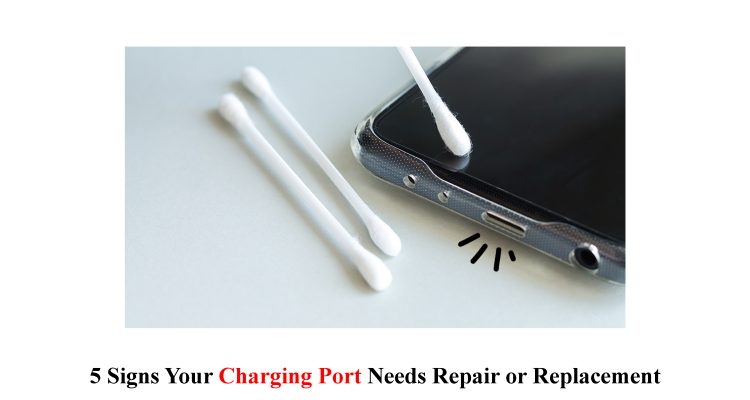
Introduction to charging ports
Have you ever experienced the frustration of a dying phone battery, only to realise that your trusty charging port is no longer doing its job? We’ve all been there. The charging port is essential to our beloved smartphones and other electronic devices, allowing us to power up and stay connected with the world. But what happens when this crucial gateway starts showing signs of wear and tear? In this blog post, we’ll explore the 5 telltale signs that your charging port may need some serious TLC. So grab your charger (if it still works!), and dive in!
Common signs of a faulty charging port
Common signs of a faulty charging port can be frustrating and inconvenient, especially in today’s digital age, where our devices are essential to our daily lives. If you’re experiencing any of these issues, it may be time to look closer at your charging port.
One common sign is help getting your device to charge appropriately. You may notice that the charging cable doesn’t sit snugly or that you must position it just right to start charging. This could indicate a loose or damaged connection within the charging port.
Another indicator is slow or inconsistent charging. If your device takes longer than usual to charge or if the battery drains quickly even when plugged in, there may be an issue with the charging port’s ability to deliver power efficiently.
Physical damage, such as bent pins or debris inside the port, can also cause problems. Bent pins can prevent proper contact between the cable and the port, while debris can obstruct the connection.
Additionally, if you frequently experience intermittent connectivity while using your device plugged in, this could point to a faulty charging port. The connection may drop randomly due to a loose internal component or damaged wiring within the port.
Overheating is another red flag that something might be wrong with your charging port. If you notice excessive heat coming from either end of your charger cable when plugged into your device, it’s essential not to ignore this warning sign, as prolonged overheating can lead to further damage.
Recognising these common signs of a faulty charging port is crucial for ensuring optimal performance and prolonging the lifespan of your electronic devices.
Causes of charging port damage
Your smartphone or device’s charging port can become damaged for various reasons. One common cause is improper handling or insertion of the charging cable. When you forcefully plug in the charger at an angle, it can strain the port unnecessarily and eventually lead to damage.
Another culprit behind charging port damage is dust and debris accumulation. Over time, particles like lint, dirt, and pocket fuzz can find their way into your charging port and obstruct the connection between the cable and the port itself. This buildup prevents proper contact and may result in a faulty connection or no connection at all.
Liquid damage is yet another major cause of charging port issues. Accidental spills or exposure to moisture can corrode the internal components of your device’s charging port, rendering it useless. It’s crucial to keep liquids away from your phone as much as possible to avoid this damage.
Furthermore, frequent plugging and unplugging without care can wear down the metal contacts inside your charging port. The constant friction over time weakens these connections, making them loose or unresponsive.
Using low-quality chargers with incorrect voltage output levels can also contribute to potential harm to your device’s charging port. These chargers often don’t adequately protect against power surges that could fry vital components within your charger and device.
Understanding these causes will help you take preventive measures such as gentle handling during plug-in attempts, regularly cleaning ports using compressed air or soft brushes, avoiding liquid exposure near devices’ ports, and only using certified chargers compatible with your specific model.
DIY solutions for a damaged charging port
If you’ve determined that your charging port is damaged, don’t panic. You can try a few DIY solutions before seeking professional repair or replacement.
Could you make sure to clean the charging port carefully? Over time, dirt and debris may accumulate in the port and prevent proper connection. Use a toothpick or a small brush to remove any visible dirt or lint from the port gently. Be careful not to damage the internal components while doing so.
Sometimes, the issue lies with the charging cable itself. You can try using a different cable to see if it’s just a cable problem rather than a faulty charging port. If another cable works fine, you know it’s time for a new one.
Another DIY solution worth trying is adjusting the position of the charger in the port. Sometimes, due to wear and tear, certain positions provide better connectivity than others. You can experiment with slightly tilting or angling your charger when plugging it into the port to see if that makes any difference.
In some cases, software glitches can also cause problems with charging ports. Restarting your device or performing a factory reset might resolve these issues temporarily until further repair is sought.
While these DIY solutions may sometimes work, it’s essential to exercise caution and avoid applying excessive force or using sharp objects during cleaning attempts. If none of these methods proves successful after repeated attempts, it’s best to seek professional help from an authorised technician specialising in charging port repairs.
Attempting complex repairs with proper knowledge could improve the situation and create more significant issues for your device.
Stay tuned for our next blog post to discuss when to seek professional repair or replacement for your damaged charging port!
When to seek professional repair or replacement
When it comes to your charging port, there may come a time when the damage is beyond what you can fix on your own. While there are DIY solutions that can temporarily address specific issues, it’s essential to know when it’s time to seek professional repair or replacement.
One clear sign you need professional help is if your charging port needs to be entirely functional. If, no matter how many different chargers you try, your device won’t charge, then it’s likely a more severe problem that requires expert attention.
Another indication that you should consult a professional is if you notice physical damage to the charging port. For example, if the port appears loose or bent out of shape, attempting to fix it yourself could cause further harm and render the device unusable.
Also, if you have already tried basic troubleshooting steps like cleaning the charging port and using different cables without success, it would be best for you. They will have specialised tools and knowledge to diagnose and repair underlying issues.
Remember, tackling complex repairs without proper expertise can lead to irreversible damage. So don’t hesitate to reach out for professional help when needed – they’ll be able to accurately assess whether a repair or replacement is necessary for your device’s charging port to function optimally once again.
The importance of regular maintenance for your charging port
Regular maintenance is essential to ensure your charging port’s longevity and proper functioning. Like any other electronic device, charging ports can accumulate dust and debris over time, leading to poor connection or damage. By incorporating a few simple habits into your routine, you can prevent potential problems and prolong the lifespan of your charging port.
It is essential to clean your charging port regularly if you don’t mind. Dust, lint, and other particles can easily get trapped in the port, obstructing the connection between your charger and device. Use a soft brush or compressed air to gently remove debris from the port.
Please don’t put extra strain on your charging cable. Pulling or twisting it excessively can weaken its connections with both ends – the charger plug and the phone’s port. Always handle cables with care by gripping them firmly near their connectors.
Also, consider using surge protectors or power strips with built-in surge protection when charging multiple devices simultaneously. These devices help safeguard against voltage fluctuations that harm your charging ports and other valuable electronics.
In addition to these preventive measures, stay vigilant for signs of wear or damage, such as loose connections or bent pins inside the port. If you notice any abnormalities during daily use or while connecting/disconnecting cables, it’s best to ask for professional assistance as soon as possible before further damage happens.
By practising regular maintenance for your charging ports by cleaning and carefully handling cables and being mindful of potential hazards like power surges, you can significantly ensure optimal performance and extend their lifespan.
Conclusion
Your charging port is a vital electronic device component that deserves attention and care. By knowing about the signs of a faulty charging port, you can take the necessary steps to address the issue as soon as possible.
Remember, if you notice any common signs mentioned earlier, such as loose connections, slow or inconsistent charging, or difficulty plugging in your charger, it’s essential not to ignore them. Attempting DIY solutions like cleaning the port or adjusting the cable may sometimes work, but seeking professional repair or replacement is recommended for more severe damage or recurring issues.
Regular maintenance can also help extend the lifespan of your charging port. Simple practices like keeping it clean and avoiding excessive bending or twisting of cables can go a long way in preventing damage. Additionally, investing in high-quality chargers and cables can reduce stress on the port and minimise potential issues.
By taking proactive measures to maintain and address any problems with your charging port quickly, you can ensure an uninterrupted power supply for your devices and avoid inconvenience caused by a malfunctioning port.
Please keep an eye out for those telltale signs that indicate your charging port needs repair or replacement. Don’t delay seeking assistance when needed – ensuring a reliable power connection is crucial for staying connected in today’s digital world!
Read More: Navigating the App Store: How to Choose the Best Mobile Apps for Your Needs


